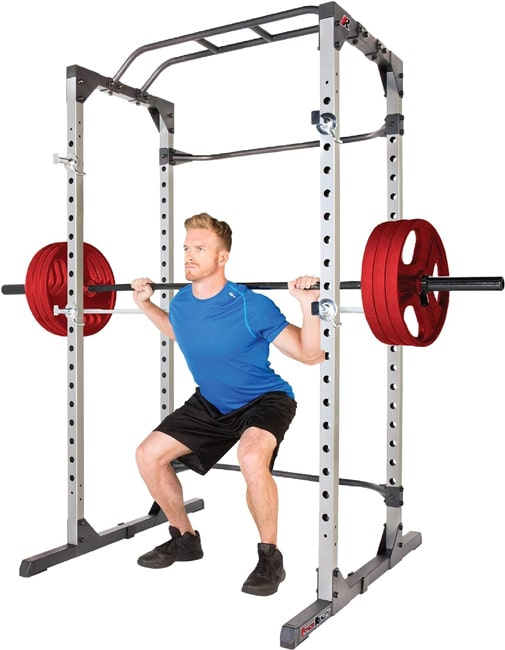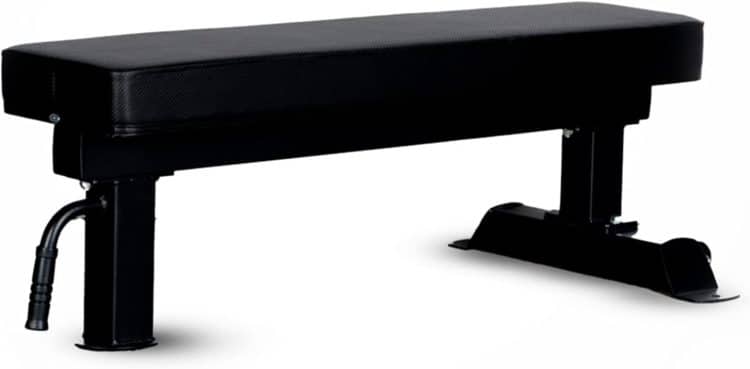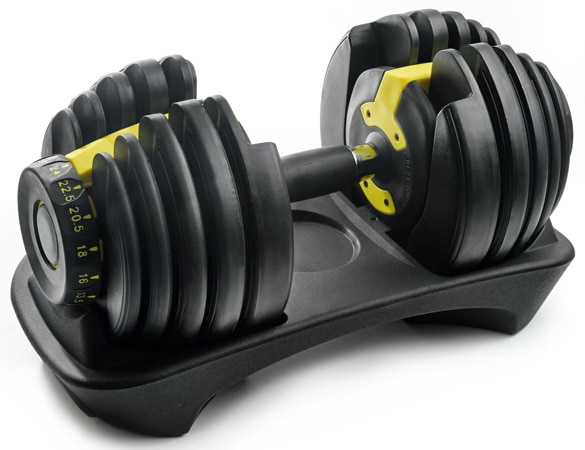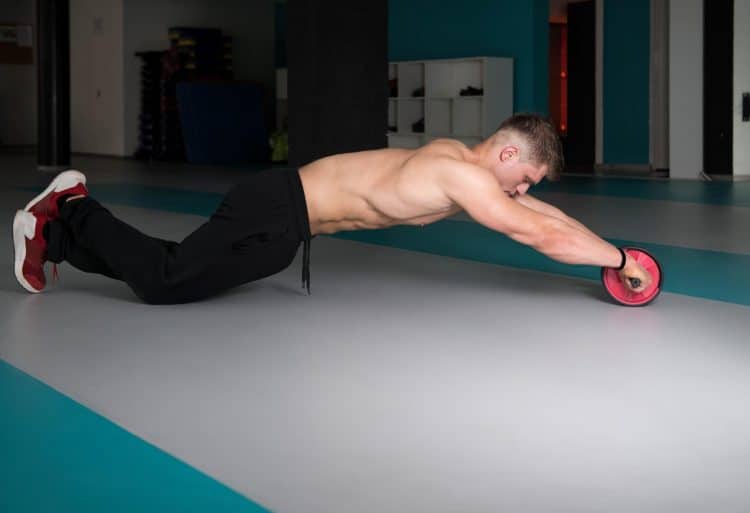As well as being a veteran personal trainer with over three decades of professional experience, I’m also a former powerlifter. And while my best lifts didn’t win any titles or break any records, I’m proud of my achievements, especially as I only came into the sport in my mid-40s.
What’s probably most surprising is that I didn’t train in a state-of-the-art gym or a dedicated powerlifting facility. Instead, I trained at home. Despite this, I successfully pulled a triple bodyweight deadlift.
Contrary to popular opinion, you don’t need a lot of space or expensive equipment to train for powerlifting. In fact, you can set up a very serviceable compact powerlifting gym in a spare bedroom or garage.
In this article, I outline the essential kit you’ll need to train for powerlifting at home, plus a few bonus items for making your workouts even more effective.
Essential Equipment for a Home Powerlifting Gym
So, you want to build your very own powerlifting home gym. You won’t regret it! This is the essential equipment you need for your strength and muscle-building workouts.
Power Rack
Powerlifting workouts invariably involve lifting heavy weights. And, if you train at home, you’ll probably be alone. Consequently, a good power rack is a must. Power racks are big and can be expensive, but I believe they’re essential for safe and effective powerlifting training.
Having a power rack means you can squat and bench press in absolute safety, even if you train to failure. Many power racks also come with pull-up and even dip bars, giving you more workout options.
Additionally, using the adjustable safety bars, you can perform various assistance exercises, such as dead-stop squats and bench presses, rack pulls, and overcoming isometrics. Most power racks also offer weight plate storage, making it easier to keep your home gym tidy.
There are many different power racks to choose from, so you should have no problem finding a model that fits your budget and the available space. Alternatively, if you are a practical kind of person, you can also construct your own. Find out how in our guide to DIY power racks.
Related: The 9 Best Squat and Power Racks Reviewed
Barbell and Collars
Powerlifting is a barbell sport where competitors test their strength in the squat, bench press, and deadlift. So, it makes sense that you’ll need a barbell for your powerlifting home workouts.
An IPF (International Powerlifting Federation) standard powerlifting barbell is 220cm or 7′ 2″ long and weighs 20 kilograms or 44 pounds. They have knurled or textured grips to stop your hands from slipping during bench presses and deadlifts. While there are special bars available for deadlifts, a general powerlifting bar should be sufficient for most lifters.
Ideally, you need a powerlifting bar made for heavy weights. Look for bars rated well above the loads you anticipate lifting – at least 1,000 pounds for most people.
Even if you do all your lifting in a power rack, you should still use collars/safety clips with your barbell. This will prevent the weights from slipping off the end of the bar unexpectedly, which can cause severe injury.
Weight Plates
You’ll need an ample supply of weight plates for your home powerlifting workouts. Make sure you have a selection of sizes so you can fine-tune your training loads.
Ideally, you should have at least a couple of pairs of full-size 20kg/44-pound plates to ensure your barbell is the right height for deadlifts. However, you can make up the rest of your weights with lighter, smaller plates.
There are lots of different types of weight plates to choose from, including rubberized bumper plates, vinyl-coated iron plates, and plain metal plates.
Plain plates are generally cheaper, but they’re also noisier to use, prone to rusting, and more likely to damage your floor. As such, you may lose the money you saved buying cheaper plates when you have to get gym floor mats.
The good news is that whichever weight plates you buy, they should last a lifetime, and you can always purchase more as you get stronger; there is no need to buy a complete set straight out of the gate.
Bench
The last powerlifting home gym essential is a bench. You’ll need a bench for bench presses and any other lying exercises you add to your workouts, e.g., barbell skull crushers. You’ll also be able to use your bench for box squats, Bulgarian split squats, and other assistance exercises.
At the very least, you’ll need a flat bench. However, an adjustable bench means you’ll have more training options and will be able to do a wider variety of exercises, including seated overhead presses, incline/decline presses, and biceps curls.
That said, incline benches aren’t usually as strong as fixed flat benches, which is something to remember if you are a particularly powerful bencher.
Related: 11 Best Weight Benches Reviewed
Summary:
The basic things you need for a powerlifting home gym are:
- Power rack
- Barbell and collars
- Weight plates
- Bench
Armed with this equipment, you’ll have everything you need to learn and master the three powerlifts while building muscle strength and size with some basic assistance exercises.
Supplemental Home Powerlifting Gym Equipment
You can train for powerlifting using nothing but the equipment outlined in the section above. However, there are a few additional tools that you can add to your home gym set-up to make your workouts more varied and, potentially, more effective and enjoyable. These items include:
Adjustable Dumbbells
Just because powerlifting is a barbell sport doesn’t mean you won’t benefit from using dumbbells from time to time. Dumbbell exercises like incline bench presses, skull crushers, and single-arm rows will help address any muscle imbalances and add some much-needed variety to your powerlifting training.
Resistance Bands/Chains
Add an extra dimension to your barbell lifts with resistance bands or chains. Bands and chains increase the load as you approach lockout, which can help eliminate the most common bench press, squat, and deadlift sticking points. Using bands or chains with freeweights is called accommodating resistance training, which is popular with powerlifters.
Suspension Trainer/Rings
No room for dumbbells in your budget? Use a suspension trainer or gymnastics rings. You can use both to replicate many of the most common dumbbell and machine-based exercises. Suspension trainer/ring training also enhances balance and stability, which should transfer to bigger barbell lifts.
Abs Roller
Successful powerlifting requires a strong core. High-rep sets of sit-ups and crunches won’t give you the strength to stabilize your spine during heavy squats and deadlifts. However, a cheap abs roller will challenge your core muscles and build your natural weightlifting belt.
Exercise Mat
While there is nothing inherently wrong with lying on the floor to stretch or train your core, an exercise mat will make the entire process much more comfortable. You can also place the mat under your barbell, dumbbells, or bench to protect your floor.
Weighted Dip/Pull-Up Belt
Weighted pull-ups and dips are two of the best assistance exercises for powerlifting. Pull-ups build back, biceps, and forearm strength for a bigger deadlift. In contrast, weighted dips will enhance your bench press performance. The easiest and most cost-effective way to load these exercises is with a dip/chin belt.
Cardio Equipment
While cardio is not essential for powerlifting, it’s exceptionally good for your health. As such, most powerlifters should do at least a couple of 20 to 30-minute cardio sessions per week. This will be much easier if you have some home cardio equipment, e.g., a bike, rower, or treadmill. You can also use your cardio machine for warming up.
Read also: 56 Gym Equipment Names with Pictures
Things to Consider Before Building a Home Powerlifting Gym
Having a home gym is pretty sweet, and there are several benefits to not training in a commercial facility. But before you rip up your gym membership contract and start buying powerlifting equipment, hit pause for a moment and think about the following:
Do You Have Enough Space?
While you don’t need lots of square footage for a home powerlifting gym, you require at least enough space for a power rack, bench, barbell, weight plates, etc. Make sure that the room you intend to use for your home gym can accommodate the equipment you plan on buying.
Also, remember that you don’t just need enough space for your equipment but space to move around, too. Cramped conditions are not conducive to comfortable, effective training. Finally, don’t forget to check the height of your ceilings, as some squat racks are taller than others.
Are Your Floors Strong Enough?
Powerlifting equipment is heavy. Make sure your floors will support the extra weight and won’t collapse under the strain. This is not an issue for most garage gyms, where concrete floors are the norm. However, it could be a problem if you plan on building your gym in a spare bedroom or live in an apartment.
Are You Disciplined Enough to Train at Home?
A gym that’s open 24/7/365 is a double-edged sword. On the one hand, you can train whenever you like. But, on the other, it’s very easy to put your workout off if you are feeling lazy. “I’ll train later” can soon become “I’ll train tomorrow,” which then turns into “I’ll train next week.”
As such, you’ll need plenty of motivation and self-discipline to resist the pull of your TV, sofa, or bed when you should be hitting the gym and pounding the weights.
Can You Afford the Initial Set-Up Costs?
While you don’t have to spend a fortune building a home powerlifting gym, some expenditure is unavoidable. Depending on your circumstances, paying a monthly membership at a commercial facility may be more viable.
That said, if you’ve got the spare cash or can score some low-interest credit, creating a home gym can actually save you money in the long term.
Will Your Neighbors/Landlord/Family Hate You?!
Powerlifting can be a noisy affair. Weights and bars clang, and grunts and heavy breathing aren’t much quieter. That’s no issue if you live in a detached house, but it could be a real problem if you live in an apartment block.
So, think about how building your home powerlifting gym will affect your neighbors and family. Will your workouts disturb them and cause unnecessary stress and friction? Also, if you live in a rented property, will your landlord object to the repurposing of a room?
Why Build a Home Powerlifting Gym?
While I have nothing against commercial and public gyms, they’re not always the most convenient place to train, and home workouts may be a better option – even for powerlifting. These are the main reasons I prefer to do my powerlifting workouts at home.
No Need to Waste Time Commuting
Depending on where you live, traveling to and from the gym can take as long as your powerlifting workout. Needless to say, time spent traveling is better spent on training. Having a gym at home means you don’t have to commute for your workouts.
No Queues for Equipment
Successful powerlifting requires a solid training program. Knowing which exercises you are going to do on what day is critical. Unfortunately, when you train in a shared facility, there is no guarantee that the equipment you want to use will be free.
That’s no problem with assistance exercises, but it can be a real stumbling block for your key lifts.
Being the only person using your squat rack, bench press, etc., means you’ll never need to wait for the equipment you want to use or “work in” with anyone else.
No Fear of Equipment Hogging
Powerlifting workouts invariably involve doing lots of sets interspersed with lengthy rests. For example, you might do eight sets of three deadlifts with five minutes rest between each.
Needless to say, this means monopolizing whatever equipment you need, which could make you unpopular with the other gym members. Having your own squat rack, bench press, barbell, etc., means not having to say sorry for hogging the same equipment for an hour or more.
Train Whenever You Like
With your own gym, you are free to train 24/7/365. In contrast, most commercial gyms have set opening times, and many are closed on public holidays. While working around gym opening times is not impossible, it’s good to have the option of training whenever it’s most convenient.
Create Your Perfect Training Environment
Commercial gyms are set up for the average exerciser. As such, they are designed to appeal to a wide range of people. Unfortunately, that might mean they don’t match your preferences and needs.
Setting up a home gym means you have a clean slate regarding your training environment. Consequently, you can control everything from the equipment you install to the music you play. And, if you don’t like something about your home gym, it’s within your power to change it.
Save Money in The Long Term
There is no escaping the initial costs of setting up a home powerlifting gym. However, once you have bought what you need, ongoing costs will be low to none. With no gym fees to pay, you’ll recoup your investment over the coming months and years. Plus, if you buy quality powerlifting equipment, it’ll probably last a lifetime.
Closing Thoughts
While setting up a home powerlifting gym might sound expensive, it doesn’t have to be. There are plenty of budget-friendly power racks, benches, barbells, and weights available, and you can often buy what you need pre-owned.
Also, it’s worth remembering that you don’t need to buy everything all at once. Equip yourself with the basics, then add to your home gym as your budget allows. So long as you’ve got a power rack, bench, barbell, and weights, you have all you need to train for powerlifting at home.
Finally, remember how much time you’ll save by having a gym at home. Traveling to and from the gym wastes time you could otherwise spend lifting. As the saying goes, time is money!
منبع: https://fitnessvolt.com/building-powerlifting-home-gym/






